
Hida Takayama onsen spa hotel where you can enjoy Hida beef cuisine to your heart’s content
Welcome to the official site for Seiryu Hotel, Takayama City, Gifu Prefecture – Hida beef cuisine specialist

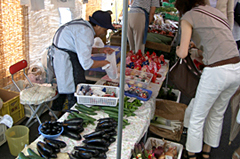
Miyagawa morning market
An array of Hida Takayama products home-made by local ladies: fresh fruit and vegetables, pickles, miso (fermented soybean paste) and folk crafts. Enjoy the overflowing energy of direct sales from producers
The morning market is open every morning even if it is raining or snowing.
◆Morning market business hours: 6:00 - 12:00 (from 7:00 in the winter: November – April), open every day of the year
◆3 minutes by foot from Seiryu Hotel


Old town
Enjoy the atmosphere of the Edo Period with rickshaws and sake breweries.
One of the pleasures of strolling around is trying out some local delicacies such as Hida beef skewers, mitarashidango (rice dumpling skewers) and Japanese-style sweets.
There is a calm, mellow ambience at night. We recommend a stroll in the cool of the evening.
◆3 minutes by foot from Seiryu Hotel


Takayama Jinya (historical government house)/Jinya Morning Market
This was originally one of the residences of Lord Kanamori of Takayama Castle. After the shogunate came into power, prefectural governors or county representatives used it as their government office and took over the government of Hida.
There is also a morning market.
◆Morning market business hours: 6:00 - 12:00 (from 7:00 in the winter: November – April), open every day of the year
◆5 minutes by foot from Seiryu Hotel

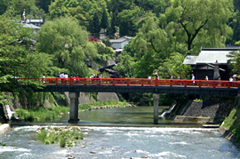
Red Nakabashi bridge
The Nakabashi bridge over the clear Miyagawa river is famous as a typical symbol of Takayama.
As the bridge is just beside Takayama Jinya (historical government house), how about visiting them both at the same time?
Furthermore, the bridge is lit up differently depending on the season and visitors can enjoy a magical atmosphere, different from that of during the day. We recommend a walk at night.
◆5 minutes by foot from Seiryu Hotel

Hida no Sato (Hida Folk Village)
Precious old Hida private houses such as those made in the gassho-zukuri style (traditional architecture with a steep thatched roof) have been dismantled and brought here to be reconstructed to create an extensive and nostalgic mountain village landscape.
Visitors can experience the traditional way of life and seasonal Hida events handed down through history.
◆ 15 minutes by car from Seiryu Hotel


Takayama Festival
Takayama Festival is famous as one of Japan’s three most beautiful festivals along with Kyoto’s Gion Festival and Chichibu’s Yomatsuri Night Festival.
This is a 400 year-old festival that started in the early Edo Period in which flamboyant festival floats are carried around the town. The float parade and the mechanical puppets are definitely worth a look.
The Takayama Festival consists of two parts: the spring festival (Sanno festival) and the autumn festival (Hachiman festival) and both of these can be accessed by foot from Seiryu Hotel (around 5 minutes).
(However, it may take more time depending on the crowds on the day.)

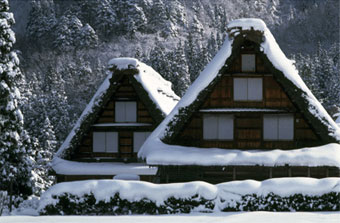
Shirakawa Village is located in the
northwestern part of Gifu Pref.and is next to Gokayama Village in Toyama pref., and west of the village are the Hakusan Mountains which border Ishikawa Pref. and Gifu Pref..
It is a typical mountain village that is
surrounded by mountains.
Mountains and forests account for 96% of the area and the remaining 0.4% is cultivated land.
◆Approx. 40 minutes by car from Seiryu Hotel (by expressway)

What is Gassho-zukuri?
Gassho-zukuri is a house built of wooden beams combined to form a steep thatched roof that resembles two hands together. You can see houses such as these in other parts of the country. In Shirakawa, they are called "Kiritsuma- Gassho-zukuri," and the roof can be looked triangular just like a standing book open.It is the characteristic of these houses in this country.
The structure is built to suit the
environment in Shirakawa. It is made to with stand heavy snowfall.
The house face north and south, to minimize wind resistance.
They are also built for be comfort in both summer and winter. The houses stand in a certain direction to adjust the amount of sun in order to keep the room cool in the summer and warm in the winter.
Illustrator: Toshikazu Takahashi
from How many Gassho-zukuri houses can be created?
A record of the Transmission of
Shirakawago
Techniques
Published by Shirakawa Village Board of Education /
Edited by the People's Cultural Images Research Institute
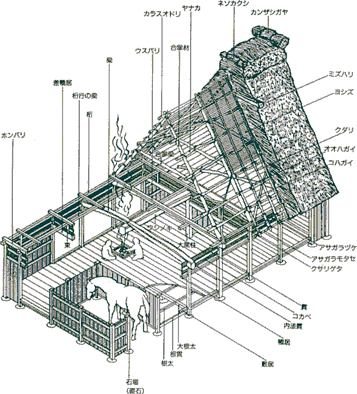
Outline of Shirakawago Gassho-zukuri settlement
(Ogimachi settlement)
− The history of the preservation movement −
Gassho-zukuri houses were built from the middle of the Edo Period to the beginning of the Showa Period in the area from Shirakawa Village to the Gokayama district in Fukui Prefecture. The oldest buildings are said to be 300 years old. However, numbers decreased from 1945 onwards due to submersion through dam projects to develop electrical power resources from the Shogawa River. Further, there were mass exoduses from smaller settlements or they disappeared due to fire and Gassho houses were re-sold or disappeared.
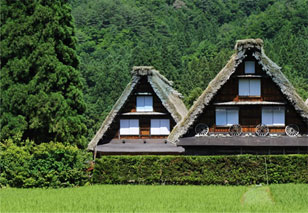
The approximately 300 houses that existed in 1924 had decreased severely to 190 by 1961. Under such circumstances, from 1965 onwards, Ogimachi settlement community residents began to organise a movement to preserve the Shirakawa Village Gassho-zukuri before it disappeared. In 1971, three basic rules were set out: not to sell, rent out or destroy resources within the community and a consensus of opinion among all the residents launched the Association for the Preservation of the Natural Environment of the Shirakawa Ogimachi Settlement and this developed preservation activities. These preservation activities were recognised and in 1976, it was designated nationally as an important traditional architectural preservation area and registered as a World Heritage Site in 1995. In 1997, the World Heritage Site Shirakawago Gassho-zukuri Preservation Foundation was established and it conducts scenery preservation activities.
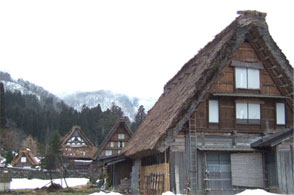
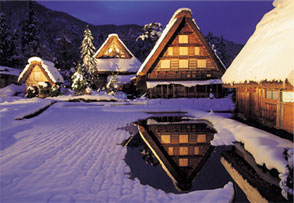
●Height above sea level: 496m
●Designated as a National Cultural Traditional Architectural Preservation Area 4th September, 1976
●Registered as a World Heritage Site 9th December, 1995
●Area: 45.6ha
●No. of structures
Gassho-zukuri structures: 114 (109 of which are designated as traditional architectural structures)
Non-Gassho-zukuri structures: 329 (8 of which are designated as traditional architectural structures)
Manufactured articles: 7 (Shinto shrine archways, hanging lanterns, stone walls)
Environmental: 8 (company business, trees, waterways, etc.)
●Population: approx. 600, No. of households: approx. 150
●Association for the Preservation of the Natural Environment of the Shirakawa Ogimachi Settlement Official Website
− Bruno Taut's Discovery −
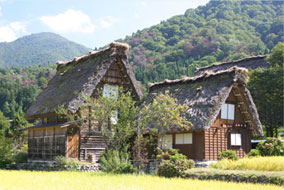
The reason that the Shirakawago Gassho-zukuri became so widely known is said to be due to the mention of Gassho-zukuri in 'Rediscovering the Beauty of Japan' written by the famous German architect, Bruno Taut (1880-1938).
Bruno Taut spent more than 3 years in Japan
travelling all over the country and rediscovering the beauty of Japan. He visited Shirakawago in May of 1935.
In his book, Bruno Taut praised the 'Gassho-zukuri houses as architecturally rational and logical' and
stated that 'this scenery is not typically Japanese. At the very least, it is not the kind of scenery I have ever seen before. This is more Swiss, otherwise an illusion of Switzerland.' Due to this high praise, it became the focus of attention of people from all over the world.
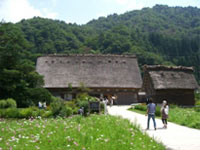
Built in the mid to late Edo Period, this well-preserved house is the largest remaining Gassho style house in Shirakawa-go. Documents and licenses still in the possession of the family show that the house was home to an official who dealt in raw silk and niter. Admission fee adult ¥300-, child ¥150-
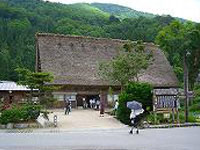
The Family whose pedigree continued for 250 years, and because the family practiced medicine from the first to third generation, there are many medical instruments remaining from the Edo Period. It is a Gassho-style house standing five stories high. A pillar that is 11 meters long(rafter) supports the huge sloping roof from the ground to the top, shaping big roof. Admission fee adult ¥300-, child ¥150-
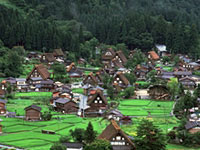
The many traditional Gassho Style houses have been designated as World Heritage.he scene of 114 houses with thatched roofs in Gassho style remind us of ancient Japan. Ogimachi-Jyoshi (the observation platform) commands a wonderful panorama of this village.
Doburoku Matsuri Festival14th - 19th Oct.
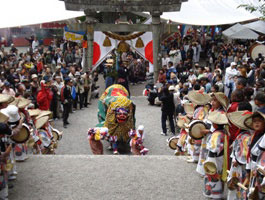
People pray to the mountain god for safety and a good harvest and offer doburoku(unrefined sake) to the shrine to express their gratitude. While private alcoholic beverage production is banned in Japan, people in Shirakawa are given special permission to produce doburoku for a limited quantity for this festival. Doburoku looks like rice porridge. It is thick and slightly sweet. Doburoku first offered to the shrine later entertains people gathered in the precincts. People there dance, perform niwaka(improvised buffoonery), sing songs and so on. The Doburoku Matsuri Festival is the biggest among the festivities for the villagers.
| District | Shrine | Festival day |
|---|---|---|
| Ogimachi | Shirakawa Hachiman Shrine | 14th - 15th Oct. |
| Hatogaya | Hatogaya Hachiman Shrine | 16th - 17th Oct. |
| Iijima | Iijima Hachiman Shrine | 18th - 19th Oct. |
| Kitani | Kitani Hakusan Shrine | 10th Oct. |
| Hirase | Hirase Hachiman Shrine | 25th - 26th Sep. |
| Schedule | Contents | Notes |
|---|---|---|
| 9:00- | festival | Shinto rites Ceremony at a shrine Parade |
| 9:00- | going round the town | Parade |
| 15:00-16:00 | dedicating Shishimai | Precincts of a shrine |
| 15:00-16:00 | blessing with Doburoku | Precincts of a shrine |
| 15:00-16:00 | dedicating the folk songs | "Hougei-den" at a shrine |
| 19:00- | dedicating Shishimai | Precincts of a shrine |
| 21:00- | dedicating public entertainment |
"Hougei-den" at a shrine |
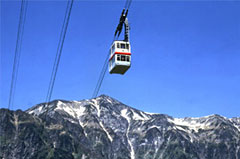
A mountain ropeway that links Shinhotaka onsen spa and Sengokudaira. It boasts a magnificent view of the Northern Alps from Shinhotaka and it is the largest-scale ropeway in the East and the second largest in the world. How about a walk in the clouds of the Northern Alps through the seasons?
◆90 minutes by car from Seiryu Hotel





